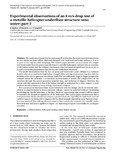- CERES Home
- →
- School of Engineering (SoE)
- →
- Staff publications (SoE)
- →
- View Item
JavaScript is disabled for your browser. Some features of this site may not work without it.
| dc.contributor.author | Hughes, Kevin | - |
| dc.contributor.author | Vignjevic, Rade | - |
| dc.contributor.author | Campbell, James C. | - |
| dc.date.accessioned | 2011-11-13T23:19:55Z | |
| dc.date.available | 2011-11-13T23:19:55Z | |
| dc.date.issued | 2007-01-01T00:00:00Z | - |
| dc.identifier.citation | K Hughes, R Vignjevic, J Campbell. Experimental observations of an 8 m/s drop test of a metallic helicopter underfloor structure onto water: part 2. Proceedings of the Institution of Mechanical Engineers, Part G: Journal of Aerospace Engineering, Volume 221, Number 5 (2007), pp. 679-690 | - |
| dc.identifier.issn | 0954-4100 | - |
| dc.identifier.uri | http://dspace.lib.cranfield.ac.uk/handle/1826/2714 | |
| dc.description.abstract | This is the second part of a two-part paper that describes the experimental observations for two similar sections of floor that were dropped onto both hard and water surfaces at 8 m/s, as part of one experimental campaign. The current paper provides an assessment of a simple box-beam under floor structure typically found in metallic helicopters and provides an overview of the failure modes and the collapse mechanism observed when dropped onto water at 8 m/s, as well as providing quantitative data for the skin deflections observed. The results demonstrate that the lack of frame and intersection joint collapse is a common feature, which is caused by the high failure strength of the existing construction, together with the inability of the skin to generate membrane loads that are sufficiently large to trigger progressive collapse within the structure. It is therefore recommended to reduce the collapse force of the structure through the use of geometry, material type, and inclusion of triggers. However, the caveat with this approach is that if the failure strength is optimized for a water impact, a poor crashworthy response may occur during a hard surface impact. The current paper discusses three main limitations with the design, which are heavily interrelated, as improvements in frame and joint collapse cannot be achieved without considering developing the ductile behaviour of the skin. However, maintaining skin integrity will be critical to maintain the floatation capabilities of the helicopter. The current paper recommends that a next generation design should encompass a passive dual role capability for both hard and soft surface impacts, by being able to degrade the localized strength depending upon the type of surface encountered. This will significantly improve the crashworthy response of a metallic under floor structure and have a significant impact on improving occupant survivability for an impact on water. | en_UK |
| dc.language.iso | en_UK | - |
| dc.publisher | Professional Engineering Publishing | en_UK |
| dc.subject | crashworthiness | en_UK |
| dc.subject | helicopter | en_UK |
| dc.subject | testing | en_UK |
| dc.subject | water | en_UK |
| dc.subject | failure | en_UK |
| dc.subject | design | en_UK |
| dc.title | Experimental observations of an 8 m/s drop test of a metallic helicopter underfloor structure onto water: part 2. | en_UK |
| dc.type | Article | - |
Files in this item
This item appears in the following Collection(s)
-
Staff publications (SoE) [603]
